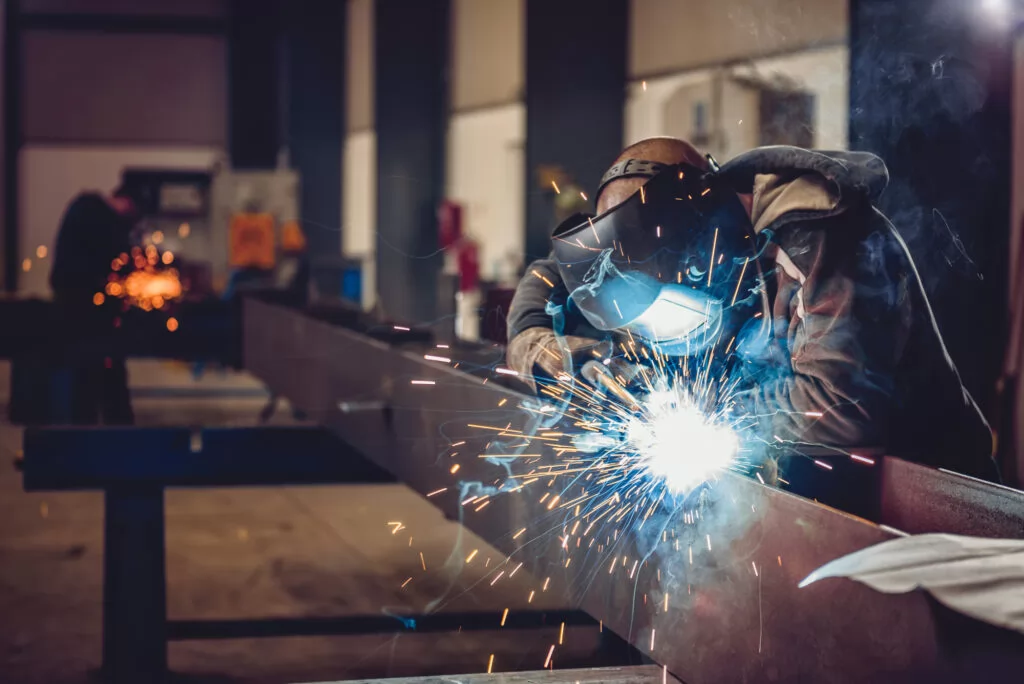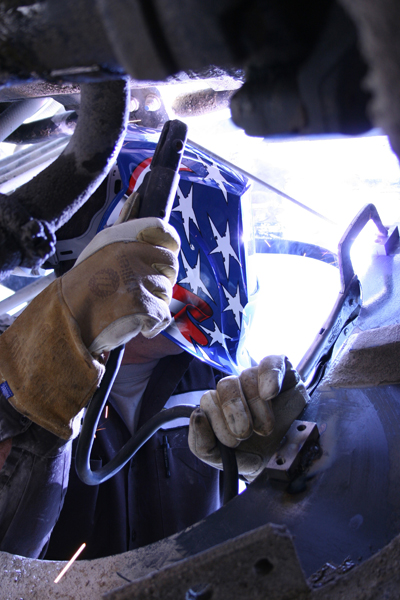Usual Welding Repair Issues and Exactly How to Address Them Successfully
Welding repair work often experience a series of problems that can jeopardize the stability of the end product. Common problems consist of insufficient penetration, porosity, and imbalance, amongst others. Each flaw provides one-of-a-kind difficulties that need certain strategies for resolution. Comprehending these problems is vital for welders aiming to boost their skills and results. This conversation will check out these usual welding fixing problems and efficient methods to address them.
Inadequate Penetration
Inadequate penetration occurs when the weld steel falls short to completely fuse with the base product, resulting in weak joints and possible architectural failures. This concern often comes from not enough heat input, incorrect electrode angle, or improper welding rate. Welders might run into insufficient penetration due to a mistake of the required parameters for a specific material thickness or kind. In addition, contamination on the base material's surface area can prevent efficient bonding, aggravating the trouble. To attend to inadequate penetration, welders should assure proper settings on their tools and preserve a clean work surface area. Regular examination of welds is suggested to recognize any deficiencies early, permitting prompt modifications and the avoidance of compromised structural integrity in bonded assemblies.
Porosity
Porosity is a common issue in welded joints that shows up as tiny gas bubbles trapped within the weld metal. This defect can jeopardize the stability of the weld, resulting in decreased stamina and prospective failing under anxiety. Welding. Porosity usually occurs from contamination, wetness, or inappropriate welding methods, which enable gases to run away into the molten weld swimming pool. To attend to porosity, welders should ensure correct surface prep work, maintain a clean workplace, and use ideal welding parameters. Additionally, picking the appropriate filler product and protecting gas can mitigate gas entrapment. Routine assessment and screening of welds can help determine porosity early, guaranteeing timely corrective activities are taken, therefore maintaining the quality and reliability of the bonded framework
Imbalance
Misalignment in welding can occur from various variables, consisting of inappropriate setup and thermal growth. Comprehending the origin creates is vital for efficient resolution. A number of modification methods are readily available to straighten parts and assure architectural honesty.
Reasons of Misalignment
Welding imbalance often originates from a range of underlying issues that can compromise structural honesty. One main reason is incorrect fit-up of parts before welding, which can result in gaps and unequal surface areas. Variants in thermal expansion during the welding process can additionally lead to distortion, especially if the products being joined have various coefficients of growth. Furthermore, inadequate fixturing and clamping might fall short to hold components securely in location, bring about movement during welding. Improperly kept equipment, including welding equipments and devices, may present incongruities in the weld grain, further adding to misalignment. Lastly, driver error, originating from inadequate training or experience, can additionally play a substantial function in creating misaligned welds.
Modification Techniques Readily Available
Dealing with imbalance successfully calls for a mix of corrective techniques tailored to the specific problems available. One typical method is making use of fixtures or jigs to hold parts in the right placement during welding, making sure consistent placement. In addition, pre-heating the materials can assist reduce distortion and improve fit-up. For significant imbalance, mechanical adjustment methods, such as using hydraulic jacks or clamps, can be utilized to correct the placement before welding. Post-weld heat treatment may also be necessary to alleviate stress and anxieties triggered by imbalance. Finally, mindful assessment and adjustment during the configuration phase can prevent imbalance problems from ending up being substantial troubles, advertising a smoother welding process and boosting general structural stability.
Distortion
Distortion is an usual obstacle in welding that can arise from various elements, including uneven home heating and cooling. Understanding the causes of distortion is necessary for implementing efficient prevention methods. Addressing this concern not only enhances architectural integrity however also boosts the total top quality of the weld.
Sources of Distortion
When subjected to the intense warmth of welding, materials often undertake modifications that can cause distortion. This phenomenon primarily occurs from thermal growth and tightening throughout the welding procedure. As the weld location warms up, the material increases; upon cooling, it contracts, which can develop interior stresses. In enhancement, irregular home heating across a workpiece can worsen these tensions, resulting in warping or flexing. The sort of material additionally plays a considerable function; steels with differing thermal conductivity and coefficients of development might respond in different ways, causing unforeseeable distortions. In addition, poor joint style and insufficient fixturing can add to imbalance throughout welding, raising the possibility of distortion. Comprehending these reasons is crucial for reliable welding repair and avoidance methods.
Avoidance Techniques
Efficient avoidance methods for distortion throughout welding emphasis on managing warmth input and making sure correct joint design. Preserving a regular warm input assists to decrease thermal development and tightening, which can bring about distortion. Making use of strategies such as preheating the work surface can likewise minimize the temperature level gradient, advertising consistent home heating. Additionally, selecting proper joint designs, such as T-joints or lap joints, can improve security and minimize stress focus. Applying correct fixturing to secure the work surfaces in position further aids in preserving placement during the welding process. Staggered welding series can disperse heat extra evenly, avoiding localized distortion. By using these strategies, welders can considerably reduce the likelihood of distortion and enhance Click Here the overall top quality of their welds.
Fracturing
Fracturing is a typical issue run into in welding repair work, usually resulting from various variables such as improper air conditioning rates, product selection, or inadequate joint preparation. The event of fractures can considerably endanger the integrity of the weld, causing potential failures throughout operation. To address this issue, welders have to first assess the source, making certain that materials work and suitably picked for the details application. Furthermore, managing the cooling price during the welding procedure is essential; quick cooling can induce tension and lead to splitting. Correct joint design and prep work likewise contribute to minimizing the risk. Executing these approaches can boost weld quality and durability, eventually minimizing the probability of breaking in finished weldments.

Incomplete Combination
A substantial issue in welding repair work is insufficient fusion, which takes place when the weld metal does not appropriately bond with the base product or previous weld passes - Fabrication. This issue can result in weak points in the joint, possibly jeopardizing the honesty of the welded structure. Elements adding to incomplete fusion consist of inadequate heat input, improper welding method, and contamination of the surfaces being signed up with. To address this concern efficiently, welders need to guarantee appropriate pre-weld cleansing and surface prep work, in addition to change their welding parameters to achieve ample penetration and blend. Routine evaluation throughout the welding process can likewise aid recognize incomplete combination early, allowing for timely rehabilitative steps to enhance the overall quality of the weld
Overheating
While welding fixings can boost structural stability, overheating presents a significant difficulty that can result in product degradation. Extreme warmth during welding can alter the mechanical properties of steels, resulting in lowered strength, enhanced brittleness, and bending. This phenomenon is specifically critical in high-stress applications where structural integrity is critical. Determining overheating can entail visual assessments for staining or distortion, in addition to monitoring temperature throughout the welding procedure. To mitigate the dangers related to getting too hot, welders should employ ideal methods, such as managing warm input, changing traveling speed, and utilizing ideal filler materials. In addition, applying pre- and post-weld heat therapies can aid bring back material residential properties and boost the overall high quality of the fixing, ensuring lasting efficiency and safety and security.
Regularly Asked Concerns
What Are the Common Signs of a Welding Defect?

How Can I Evaluate My Welds for Quality?
To evaluate welds for high quality, one can utilize visual evaluations, ultrasonic screening, and radiographic techniques. Each method ensures architectural stability, determines defects, and confirms adherence to defined requirements, eventually boosting the dependability of the welded joints.
What Safety and security Precautions Should I Take While Welding?
When welding, one ought to focus on safety and security by wearing proper individual safety devices, making certain appropriate ventilation, protecting combustible products away, keeping a clean work area, and being conscious of surroundings to stop crashes and injuries.
Can I Repair a Weld Without Remodeling the Entire Joint?
Repairing a weld without redesigning the entire joint is feasible, depending upon the damage (Belgrade Fabrication). Strategies additional hints such as grinding, adding filler product, or making use of a welding process can effectively attend to particular flaws while preserving the bordering framework
What Equipment Are Vital for Reliable Welding Repairs?
Important devices for effective welding fixings include a welding device, wire brush, mill, safety equipment, clamps, and filler products. Each tool plays a vital role in making sure top quality and look what i found safety and security during the repair procedure. Porosity generally emerges from contamination, moisture, or improper welding strategies, which permit gases to get away right into the molten weld swimming pool. Improperly kept tools, including welding makers and tools, may present inconsistencies in the weld grain, additional contributing to misalignment. When subjected to the extreme warm of welding, materials usually go through adjustments that can lead to distortion. Breaking is an usual issue come across in welding fixings, usually resulting from various elements such as improper air conditioning prices, product option, or inadequate joint preparation. A significant problem in welding repair services is incomplete blend, which occurs when the weld steel does not adequately bond with the base product or previous weld passes.